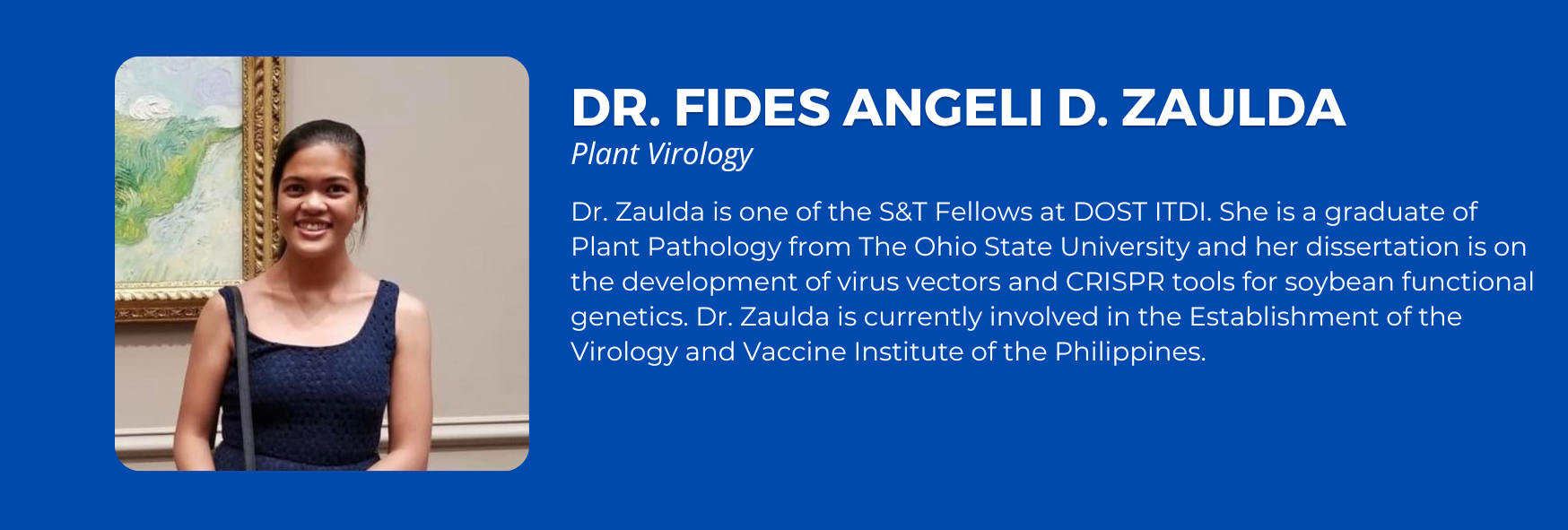
Sex: Female
Education:
- Doctor of Philosophy in Plant Pathology, The Ohio State University, USA, 2021
- Master of Science in Plant Pathology, The Ohio State University, USA, 2021
- Master of Science in Molecular Biology and Biotechnology, University of the Philippines, 2015
- Bachelor of Science in Molecular Biology and Biotechnology, University of the Philippines, 2010
Field of Specialization:
Plant virology
Biotechnology
Genome editing for crop improvement
Molecular Biology
Researches:
Article title: Immunodiagnosis of bunchy top viruses in abaca with polyclonal antibodies against their recombinant coat proteins
Authors: Koh, Rhosener Bhea L. Zaulda, Fides Angeli D. L. C. Barbosa, Cris Francis C. Aquino, Vermando M.; et al.
Publication title: Archives of Phytopathology and Plant Protection 53: 82-98, 2020
Abstract:
Polyclonal antibodies against abaca bunchy top virus (ABTV) and banana bunchy top virus (BBTV) proteins are necessary for immuno-based detection of these two viruses in abaca (Musa textilis Nee). In this study, recombinant bunchy top viral coat proteins fused with a 6xHis tag at the N-terminus were expressed in E. coli BL21Starᵀᴹ(DE3)pLysS strain and purified under denaturing conditions. Purified recombinant ABTV and BBTV coat proteins were used as antigens for the production of rabbit polyclonal antibodies. IgG was purified and evaluated by Direct Antigen Coating (DAC)-ELISA and further optimized by testing primary to secondary antibody dilution combinations. Analysis of ABTV and BBTV-infected abaca samples using the optimized DAC-ELISA assay showed that the anti-ABTV CP IgG can react to BBTV and that anti-BBTV CP IgG can react to ABTV, hence, a cross-reaction. The study demonstrates the advantage of using recombinant DNA technology for mass production of antigens for antibody production. Although specificity of the polyclonal antibodies may have been compromised when renatured recombinant proteins were used as immunogens, the ability of the purified IgGs to detect positive abaca samples reveals that the DAC-ELISA can be routinely used for screening disease-free abaca planting materials.
Full text available upon request to the author
Article title: Generation of a Cowpea severe mosaic virus infectious clones.
Authors: Fides Angeli Zaulda,. Shaoyan Zhang, Feng Qu, Junping Han
Publication title: APS Annual Meeting, Cleveland, 2019
Abstract:
Infectious clones are important for functional studies of plant RNA viruses. Cowpea severe mosaic virus (CPSMV; Genus Comovirus, Family Comoviridae) is an RNA virus with a bipartite genome consisting of two single-stranded, plus-sense RNA segments. CPSMV is a well-known pathogen of cowpea, soybean, and other legume species. The RNA1 encodes proteins involved in replication, whereas the RNA2 encodes the movement protein and two coat proteins. In this study, we generated an infectious clone of a CPSMV variant able to infect tobacco (Nicotiana benthamiana) and soybean (Glycine max). The full-length cDNAs obtained from the CPSMV CB strain were cloned separately into the pAI101 binary vector downstream of a CaMV35S promoter with duplicated enhancers, and confirmed by restriction enzyme digestion and sequencing. Two amino acid changes were observed in the RNA1 polyprotein (S1098P and K1651R) when compared to the NCBI reference sequence (NC_003545.1), and none in the RNA2 polyprotein. The construct was introduced into lima bean cotyledons using particle bombardment. Inoculation with lima bean extracts resulted in systemic infection in both tobacco and soybean hosts. Infectivity was also retained throughout passages from soybean to tobacco. Surprisingly, Agrobacterium (C57C1) transformed with the construct harboring RNA1 cDNA grew into extremely small colonies on the selection plate, and did not grow at all in liquid culture without introducing mutations. Analysis of CPSMV mutants containing systematic deletions showed that the toxicity was imparted by a region in the N-terminal portion of the viral RNA-dependent RNA polymerase. This CPSMV infectious clone can be used as a plant virus vector to express foreign proteins or RNA, to study synergy between different comoviruses, and to study superinfection exclusion among bipartite viruses.
Full text available upon request to the author
Article title: Bean pod mottle virus (BPMV)-mediated expression of Phytophthora sojae avirulence (Avr) proteins elicits hypersensitive response in soybean cultivars with corresponding Rps genes
Authors: Zaulda, F.A., Han, J.H., Dorrance, A.D., and Qu, F.
Publication title: 2018 Annual Meeting of the American Society for Virology College Park, MD. 14-18 July 2018.
Abstract:
No available
Full text available upon request to the author
Article title: Genetic Diversity of Banana Bunchy Top Virus (BBTV) in the Philippines.
Authors: Zaulda, F.A.D., Galvez, L.C., and V.M. Aquino.
Publication title: 2015 International Congress General Meeting, Tokyo University of
Agriculture, Tokyo, Japan. 07-09 November 2015.
Abstract:
No abstract
Full text available upon request to the author
Article title: Characterization and Recombinant Expression of Abaca Mosaic Virus Coat Protein and Production of Polyclonal Antiserum.
Authors: Zaulda, F.A.D., Galvez, L.C., and V.M. Aquino.
Publication title: 44th PSM Annual Convention. Marriott Hotel. 16-17 July 2015.
Abstract:
No abstract
Full text available upon request to the author
Article title: Recombinant Expression of Banana Bract Mosaic Virus (BBrMV) Coat Protein and Production of Polyclonal Antiserum.
Authors: Zaulda, F.A.D., Galvez, L.C., and V.M. Aquino.
Publication title: 44th PSM Annual Convention. Marriott Hotel. 16-17 July 2015.
Abstract:
No abstract
Full text available upon request to the author
Article title: Heterologous Expression of the Replication Initiation Protein (Rep) of Two Bunchy Top Viruses and Production of Polyclonal Antiserum.
Authors: Zaulda, F.A.D. and V.M. Aquino.
Publication title: 36th NAST Annual Scientific Meeting. Philippine International Convention Center. 09-10 July 2014.
Abstract:
No abstract
Full text available upon request to the author
Contact details: This email address is being protected from spambots. You need JavaScript enabled to view it.

